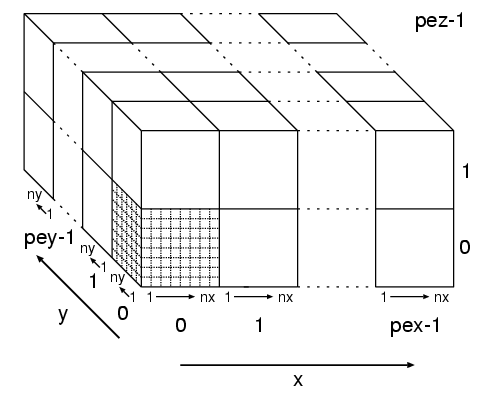Full particle code
This paragraph briefly summarizes the general features of the full-particle
code, including the underlying equations, the numerical algorithms for
the particle dynamics and Maxwell's equations, the multigrid algorithm
for Poisson's equation and the domain decomposition.
General features
The code advances the full Maxwell equations and the individual ions and
electrons. For the motion of the particles the user can choose between
the non-relativistic and the relativistic equation of motion. The dynamics
of the electric and the magnetic are determined by Faraday's and Ampere's
laws and the current density which results from the particles' positions
and velocities. Although Poisson's equation should remain satisfied automatically
discretization errors in the continuity equation may accumulate to a secular
violation, therefore the electric field needs to be corrected regularly.
The associated Poisson equation is solved in real space employing a multigrid
algrorithm and allowing for general non-periodic boundary conditions. The
data and the computational work are distributed following a 3-D domain
decomposition and all communication is performed with MPI routines.
Equations
The equations are normailzed to the ion cyclotron frequency and the ion
inertial length at reference density and magnetic field. The remaining
parameters are the ratio between the speed-of-light and the Alfven-velocity
and the ratio between electron and ion mass. This leads to the following
set of equations for the relativistic and the non-relativistic cases.
-
Maxwell's equations in normalized form (c=normalized speed of light
c/vA)
-
equation of motion for the ions
-
equation of motion for the electrons
-
parameter gamma in the relativistic/ non-relativistic equation of motion
Numerical techniques - Particle dynamics
The particles positions and momenta are advanced according to the Boris
algorithm, which basically consists of the following steps:
-
advance position with last value for the velocity for half of total time
step dt/2
-
advance velocity for full time step dt
-
advance velocity for half of total time step dt/2 according to electric
force
vnew = vold + E dt/2
(nonrelativistic case for simplicity)
-
advance velocity for full time step dt according to magnetic force
vnew - dt/2 (vnew x B) = vold
+ dt/2 (vold x B) (nonrelativistic)
-
advance velocity for half of total time step dt/2 according to electric
force
-
advance position with present velocity for time dt/2
For further details see: C. K. Birdsall, A. B. Langdon, Plasma Physics
via Computer Simulation, IOP Publ., Bristol, 1991
Numerical techniques - Maxwell's equations
Faraday's and Ampere's laws are advanced with an explicit trapezoidal leapfrog
algorithm, where all spatial derivatives are taken to second order. Although
the dynamics of the electric field is fully determined by Faradays' law
a Poisson quation should be solved: Faraday's law dE/dt = c2 (curl
B - j) implies d/dt (div E) = c2 div j = c2
d/dt rho provided the particle motion exactly satisfies the equation
of continuity. Thus except for discretization errors Farady's law and the
equation of continuity guarantee that Poisson's equation remains satisfied
if it was satisfied initially. Discretization errors in the continuity
equation however may accumulate to a secular violation of Poisson's equation.
To correct for this errors one needs to solve the Poisson equation div
grad phi = div E - c2 rho. The corrected electric field
E'
= E - grad phi then exactly satisfies Poisson's equation.
Numerical techniques - Multigrid Poisson solver
The Poisson equation is treated with a multigrid solver,
since a multigrid algorithm parallelizes very well and does not require
Fast-Fourier-Transformations which would enforce periodic boundary conditions.
A standard iterative solver substitutes the Poisson equation by a diffusion
equation.
The steady state solution then solves the Poisson equation. Advancing the
diffusion by an explicit stepping algorithm requires very small time steps,
since according to the Courant criterion the time step dt is linked
to the smallest scales
dt < dx2 . Since the large
scales modes relax very slowly (relaxation proportional to exp{-k2
t}) a prohibitively large number of time steps is required. The basic
idea of the multigrid algorithms is to treat the large scale modes on a
coarser grid. Small scale modes being absent a larger time step can be
chosen since dx is larger. Proceeding recursively from fine to coarse
grids and backwards each scale lenght is relaxed on the grid with the appropriate
resolution leading to the name multigrid.
For further details see: U. Trottenberg, C. Oosterlee, A. Schüller,
Multigrid, Academic Press, London, 2001
Domain decomposition
To efficiently use a very large number of processors on a distributed memory
machine a three-dimensional domain decomposition is used. pex, pey,
pez denote the number of processors in the x,y,z directions
whereas nx,ny,nz are the number of grid points within the
subdomain treated by one processor. Thus, the total number of grid points
per processors is given by nx x ny x nz, the total number of processors
is n_pes = pex x pey x pez and the total number of grid points is
nx
x pex x ny x pey x nz x pez.
Real grid points range from x=1,...,nx whereas x=0 and x=nx+1
represent layers of ghost cells which are used to link the domains of neighboring
processing elements. Each particle is treated by the processor that treats
the spatial subdomain in which particle is located. If the particle leaves
this domain it is transfered to the appropriate processor. Obviously a
large density variation can lead to load imbalance and therefore a performance
degradation.









